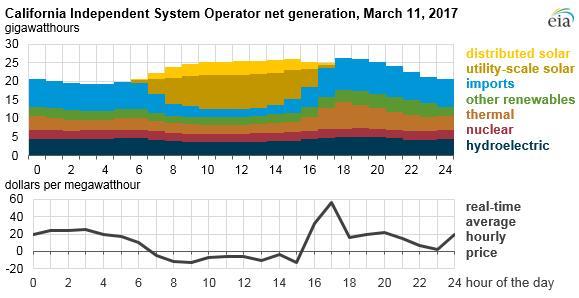California sun produces so much power that electricity prices turn negative
'In March, during the hours of 8am to 2pm, system average hourly prices were frequently at or below $0 per megawatt-hour'

Your support helps us to tell the story
From reproductive rights to climate change to Big Tech, The Independent is on the ground when the story is developing. Whether it's investigating the financials of Elon Musk's pro-Trump PAC or producing our latest documentary, 'The A Word', which shines a light on the American women fighting for reproductive rights, we know how important it is to parse out the facts from the messaging.
At such a critical moment in US history, we need reporters on the ground. Your donation allows us to keep sending journalists to speak to both sides of the story.
The Independent is trusted by Americans across the entire political spectrum. And unlike many other quality news outlets, we choose not to lock Americans out of our reporting and analysis with paywalls. We believe quality journalism should be available to everyone, paid for by those who can afford it.
Your support makes all the difference."Yeah, they're out there havin' fun, In the warm California sun," sang The Rivieras in their 1964 hit.
And it could not be more apt today as the sun in the state was so strong – and the number of solar farms so large – that electricity prices in the state have begun turning negative on the main power exchange, the US Energy Information Administration (EIA) has revealed.
Solar made up a record figure of nearly 40 per cent of the electricity sent to the grid in the California Independent System Operator’s (CAISO’s) territory for a few hours on 11 March, after utility-scale solar farms grew by almost 50 per cent in 2016, the EIA said on its website.

However, as the Quartz website pointed out, negative wholesale prices do not translate into an unexpected windfall for consumers.
This is because retail prices are based on the average cost, so people might get slightly cheaper electricity but not an actual cash payment as a result of prices becoming negative for a few hours.
The EIA said: “The large and growing amount of solar generation has occasionally driven power prices on the CAISO power exchange during late winter and early spring daylight hours to very low, and sometimes negative, prices.
“However, consumers in California continue to pay average retail electricity prices that are among the highest in the nation.”
Solar capacity in the state has grown rapidly in the last few years.
There was less than one gigawatt in 2007, but nearly 14GW by the end of last year.
At this time of year, the large amounts of sunlight and the relatively low demand can produce too much electricity around the middle of the day.
“Electricity demand in California tends to peak during the summer months,” the EIA said.
“However, in late winter and early spring, demand is at its annual minimum, but solar output, while not at its highest, is increasing as the days grow longer and the sun gets higher in the sky.
“Although the sun is at a similar angle in September and October, electricity demand is still relatively high, leading to lower solar generation shares than seen in March.
“Consequently, power prices … were substantially lower in March compared with other times of the year or even March of last year.
“In March, during the hours of 8am to 2pm, system average hourly prices were frequently at or below $0 per megawatthour.
“In contrast, average hourly prices in March 2013–15 during this time of day ranged from $14/MWh to $45/MWh.
“Negative prices usually result when generators with high shut-down or restart costs must compete with other generators to avoid operating below equipment minimum ratings or shutting down completely.”
Join our commenting forum
Join thought-provoking conversations, follow other Independent readers and see their replies
Comments